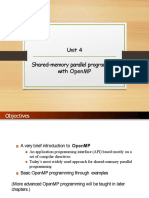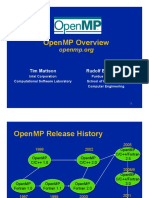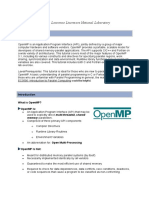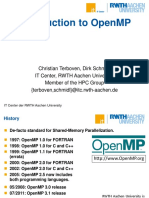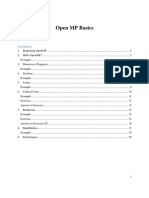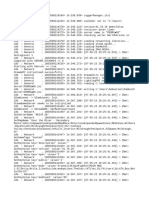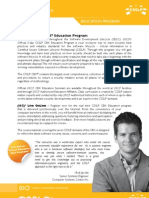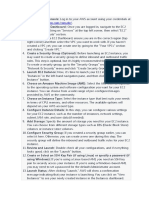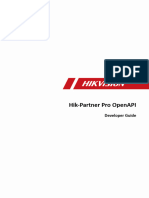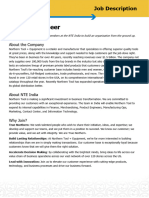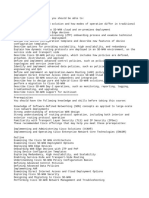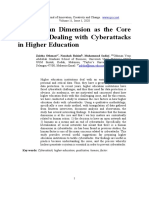K MEANS CLUSTERING USING
OpenMP
A REPORT ON PACKAGE
SUBMITTED BY
MRUDHULA G.P. – 18PD18
SAROOPASHREE K. – 18PD32
SUBJECT : OPERATING SYSTEMS
Department of Applied Mathematics and Computational Sciences,
PSG College of Technology ,
Coimbatore - 4.
0
� K MEANS CLUSTERING USING OpenMP
Abstract:
This project presents a parallelized model for K-Means Clustering to classify data
with OpenMP in C programming language.
1.1 Introduction:
OpenMP is an Application Program Interface (API), jointly defined by a group of
major computer hardware and software vendors. OpenMP provides a portable, scalable
model for developers of shared memory parallel applications.
K-means clustering is an iterative algorithm that tries to partition the dataset into K
pre-defined distinct non-overlapping subgroups (clusters) where each data point belongs to
only one group.
Iterative clustering with K-Means requires more execution time. To avoid such, a
parallel partitioning of enhanced K-Means algorithm using OpenMP is proposed to handle
the outliers with optimized execution time without affecting the accuracy.
1.2 Description:
1.2.1 What is OpenMP?
OpenMP is a set of compiler directives as well as an API for programs written in C,
C++, or FORTRAN that provides support for parallel programming in shared-memory
environments. OpenMP identifies parallel regions as blocks of code that may run in parallel.
Application developers insert compiler directives into their code at parallel regions, and these
directives instruct the OpenMP run-time library to execute the region in parallel.
1
� It creates as many threads which are processing cores in the system. Thus, for a
dual-core system, two threads are created, for a quad-core system, four are created; and so
forth. Then all the threads simultaneously execute the parallel region. When each thread exits
the parallel region, it is terminated. OpenMP provides several additional directives for
running code regions in parallel, including parallelizing loops.
In addition to providing directives for parallelization, OpenMP allows developers to
choose among several levels of parallelism. E.g., they can set the number of threads
manually. It also allows developers to identify whether data are shared between threads or are
private to a thread.
1.2.2 What is K-Means Clustering?
Most unsupervised learning-based applications utilize the sub-field called Clustering.
Clustering is the process of grouping data samples together into clusters based on a certain
feature that they share. A cluster refers to a collection of data points aggregated together
because of certain similarities.
K-means clustering is one of the simplest and popular unsupervised machine learning
algorithms. It is an iterative algorithm that tries to partition the dataset into K pre-defined
distinct non-overlapping subgroups (clusters) where each data point belongs to only one
group. The main objective is to discover underlying patterns in the given data.In other words,
k-means finds observations that share important characteristics and classifies them together
into clusters. Customer Segmentation, Document Classification, House Price Estimation, and
Fraud Detection are just some of the real world applications of clustering.
2
�1.2.2.1 Pseudocode:
The intuition behind the algorithm is actually pretty straight forward. To begin, we
choose a value for k (the number of clusters) and randomly choose an initial centroid (center
coordinates) for each cluster. One initialization approach would be to choose our initial k
positions from the dataset itself, setting one of the points as a Means value in its own
surroundings. We incorporated the latter technique in our project.
Now, the algorithm goes through the data points one-by-one, measuring the distance
between each point and the k centroids. The algorithm then groups the data point with the
closest centroid (i.e. closest in distance).
As soon as we’re done associating each data point with its closest centroid, we
re-calculate the means — the values of the centroids; the new value of a centroid is the sum
of all the points belonging to a cluster divided by the number of points in that cluster.
Once those centroids stop moving or if the difference in the coordinates of the
updated centroid from that of the previous centroid is minimal, the clustering algorithm stops
since the centroids have converged to nearly optimal value. This also means that each
3
�centroid has centered itself in the middle of its cluster, which is surrounded by its own
circular decision boundary.
1.3. API used:
OpenMP is based on SPMD (Single Program Multiple Data) which means that a
single program can work on multiple data by iterating over different data on the region of the
memory. All tasks execute their copy of the same program simultaneously
1.3.1 Fork and Join Mechanism:
The fork and join mechanism started by a master thread (also served as a main entry
to the whole program) creates other threads when it sees OpenMP directive to launch the
desired number of threads.The forked thread will be executed concurrently by CPU’s context
switching. When the forked threads complete the statements in the parallel region construct,
they synchronize and terminate, leaving only the master thread.
1.4. Technology and Tools:
The implementation of Parallelized K-Means Clustering is done with the help of the
omp.h library that is available in C language. Few basic thread controls and omp functions
are explained below.
1.4.1.Compiler Directives:
Compiler directives (aka pragmas) appear as comments in the source code and are
completely ignored by compilers unless you tell them otherwise – usually by specifying
4
�appropriate compiler flags. Compiler directives are used for various purposes like spawning a
parallel region, dividing blocks of code among threads, distributing loop iterations among
threads, synchronization of work among threads. Compiler directives have the following
syntax:
#pragma omp construct [clause [clause]…]
{ structured_block }
Most OpenMP constructs apply to a “structured block”. Structured block is a block of one or
more statements with one point of entry at the top and one point of exit at the bottom. A few
of the compiler directives are explained in detail below.
1.PARALLEL Construct
A parallel region is a block of code that will be executed by multiple threads.
This is the fundamental OpenMP parallel construct.When a thread reaches a PARALLEL
directive, it creates a team of threads and becomes the master(Thread ID = 0) of the
team.Starting from the beginning of this parallel region, the code is duplicated and all threads
will execute that code.There is an implied barrier at the end of a parallel region. Only the
master thread continues execution past this point.
Syntax : #pragma omp parallel[clause …]
{ structured_block }
2. MASTER Construct
The MASTER directive specifies a region that is to be executed only by the
master thread of the team. All other threads on the team skip this section of code. There is no
implied barrier associated with this directive
Syntax: #pragma omp master
{ structured_block }
3. CRITICAL Construct
5
� The CRITICAL directive specifies a region of code that must be executed by
only one thread at a time.If a thread is currently executing inside a CRITICAL region and
another thread reaches that CRITICAL region and attempts to execute it, it will block until
the first thread exits that CRITICAL region.
Syntax: #pragma omp critical [ name ]
{ structured_block }
4.BARRIER Construct
The BARRIER directive synchronizes all threads in the team. When a
BARRIER directive is reached, a thread will wait at that point until all other threads have
reached that barrier. All threads then resume executing in parallel the code that follows the
barrier.
Syntax: #pragma omp barrier
{ structured_block }
5.SINGLE construct
The SINGLE directive specifies that the enclosed code is to be executed by
only one thread in the team(whichever thread arrives first to the block).May be useful when
dealing with sections of code that are not thread safe (such as I/O).Threads in the team that do
not execute the SINGLE directive, wait at the end of the enclosed code block, unless a
nowait clause is specified.
Syntax: #pragma omp single [clause ...]
{ structured_block }
1.4.2 Run-Time Library Routines:
OpenMP includes several run-time library routines. These routines are used for
various purposes such as setting and querying the number of threads, querying threads’
unique identifier (thread ID), querying the thread pool size and so on. Let’s look into a few
common functions.
6
� 1. omp_get_thread_num() - Returns the thread id in a parallel region.
2. omp_set_num_threads(nthreads) - To set the number of threads used in a parallel
region.
3. omp_get _num_threads() - Returns the number of threads used in a parallel region.
4. omp_get_max_threads() - Returns the maximum number of threads used for the
current parallel region.
5. omp_get_wtime() - Returns the current time in the epoch time format.
1.5. Workflow:
The program starts by receiving the dataset filename, number of clusters(i.e., k),
number of threads and the output filename for data points and clusters separately as command
line arguments. Then the main function reads the dataset provided that the command line
arguments are properly given.
The function to read the dataset is included in the IO.h file. The readDataset()
function first scans the first line for the number of data points that is available in the file and
prints the same. After which it reads the data points’ coordinates one by one and stores it in a
hich is of type float.
2D array data_points w
Before calling the function to create clusters we record the start_time using
omp_get_wtime()function.
The function kmeansClusteringOmp() is the core function used in the code which
is defined in omp_kmeans.c file. The function is fed with the number of data points (N),the
number of clusters (k), the data points in the dataset as parameters along with the pointer
variables to store centroids and cluster points.
The function initially defines the first K data points to be the initial K cluster center
coordinates(centroids). Then it sets the number of threads to the user desired threads using
omp_set_num_threads()API.
7
� Then the cluster creation is a parallel process which is defined by #pragma omp
paralleldirective. For the clustering process we call the function threadedClustering().
threadedClustering()function finds the Euclidean distance between the data
points and all the centroids using the findEuclideanDistance()function and assigns the
data point to the cluster whose centroid is nearest to the data point.
After these steps, the position of the centroids is to be changed to the Means of the
respective data points in its cluster which is done in the critical section using the directive
.
#pragma omp critical
The above mentioned process keeps on continuing until the iteration reaches
MAX_ITERATION or until there is no significant change in the centroids position. This is
calculated by the master thread after updating the centroid position by calculating the
difference in the Euclidean distance between the previous centroid’s position and the updated
centroid’s position. Then we update the cluster points.
When all the above procedures are completed, the clustering part of the program is
said to be finished, thus making the move to the second I/O phase of the program which is
writing the clustered data points and coordinates of the centroids to two seperate files whose
filenames along with their relative path are received as command line arguments beforehand.
These I/O operations are facilitated by two functions writeClusters()and
writeCentroids()in IO.h file.
But before writing the output into files, we get the current time using
omp_get_wtime()function to calculate the time taken to cluster the points by the parallelised
kmeansClusteringOmp()f unction.
1.6 Results and discussion:
The following table shows the amount of time taken by the Parallelized K Means
Clustering algorithm in seconds when using different numbers of threads and when subjected
to different datasets having varied numbers of data points.
8
�No. of 1 2 3 4 5 6 7 8
data thread threads threads threads threads threads threads threads
points
10000 0.02383 0.01243 0.00888 0.0081 0.00672 0.006 0.00589 0.00559
50000 0.34745 0.59751 0.48475 1.15734 1.13999 0.68857 0.27585 0.37846
100000 1.10589 1.31707 0.96232 1.71705 2.27425 1.97583 1.12551 0.10571
200000 0.42701 0.39406 0.33408 0.16446 0.18864 0.10275 0.16628 0.1537
400000 0.8538 0.52517 0.2981 0.28874 0.22421 0.20025 0.22059 0.29832
500000 4.30146 23.0046 13.8327 12.0836 10.9836 10.8942 9.41344 3.31326
600000 6.16556 25.8607 15.4 14.6531 13.7482 12.4708 11.991 2.9923
800000 11.5138 34.6003 23.8081 18.1851 17.1852 15.7755 14.2817 9.7823
1000000 2.71054 1.36294 0.90934 0.69898 0.72964 0.88188 0.86656 0.42861
9
�1.7. Conclusion:
Most of the existing clustering algorithms are having less efficiency due to large
volumes of datasets and outliers. To achieve better accuracy with minimum time complexity,
a parallel enhanced clustering algorithm is proposed on multi-core systems.This project has
presented a parallelized version of the existing K-Means Clustering algorithm.
10
�1.8. Bibliography:
Websites:
1. http://www.bowdoin.edu/~ltoma/teaching/cs3225-GIS/fall17/Lectures/openm
p.html
2. https://computing.llnl.gov/tutorials/openMP/#SINGLE
3. https://www.openmp.org/wp-content/uploads/omp-hands-on-SC08.pdf
4. https://www.academia.edu/38994225/Parallelized_K-Mean_Clustering_with_
OpenMP
5. https://towardsdatascience.com/how-does-k-means-clustering-in-machine-lear
ning-work-fdaaaf5acfa0
11




